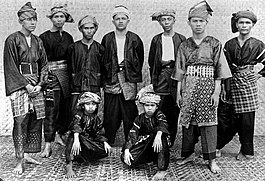Tengkolok
 Minangkabau man with a tengkolok headgear. | |
| Type | Traditional Headgear |
|---|---|
| Material | Songket |
| Place of origin | Maritime Southeast Asia[1][2] |
| Manufacturer | Malay people[3][4][5] Banjarese, Minangkabau,[6] Buginese, Makassar, Minahasa, Bajau and Kadazandusun people |
Tengkolok, also known as Tanjak, Destar (Minangkabau: Deta; Kelantan-Pattani: Semutar)[7] is a traditional Malay or Indonesian and male headgear. It is made from long songket cloth folded and tied in particular style (solek). Nowadays, it is usually worn in ceremonious functions, such as royal ceremony by royalties, and wedding ceremony by grooms.
History
According to history, tengkolok or ramp was first used by the Srivijaya community in Sumatra. In the year 750 AD, Sang Jaya Bangsa or Sang Rama Dhamjaya - King Srivijaya based in Palembang, Sumatra, attacked the Langkasuka kingdom based in the present Malay Peninsula which was then under the rule of Raja Maha Bangsa. Until the year 775 AD, Srivijaya managed to conquer Langkasuka and all its colonies. From here, the use of tanjak or tengkolok was introduced to the peninsula. However, the influence of Langkasuka culture such as "kepong" or "ketopong" remains dominant. In the peninsula itself, the rule of using tengkolok or ramp began when Seri Teri Buana was installed as a kingdom for three kingdoms namely: Sriwijaya, Bintan and old Singapore. Geographically, the Bintan Islands and the Singapore Islands are part of the Malay Peninsula. Proximity, entrance to tengkolok, ramps and these destinations start from the south to the north of the peninsula. In the following eras, after the spread of Islam, the Sultans of Malacca and Johor-Riau-Lingga-Pahang had their princes as kings or sultans in the lands of Perak, Jeram (Selangor), Johor, Terengganu and Pahang. There are also among the kings of Malacca and Johor-Riau-Lingga-Pahang who are appointed as deputy kings in colonies such as Kelang (Selangor) and Muar (Johor). Sultan Mahmud Syah (Kedah) went to Melaka to confront Sultan Mahmud Syah (Malacca) to plead for the throne. This is where the history of tengkolok or tanjak in the country of Kedah begins. The history of tengkolok or ramps in the state of Kelantan began when the Sultan of Melaka conquered the country of Serendah (Seri Indah) Sekebun Bunga under the rule of Sultan Gombak. From Kelantan, the use of tengkolok or ramp entered Patani when Patani was ruled by the king's son from the Kelantan I dynasty and the Kelantan II dynasty. In the era of the Great Federal Government of Patani, the use of tengkolok, tanjak and headbands developed in the country of Singgora (Songkhla, Phatthalung and Satun) and Ligor (Nakhon Si Thammarat). Under the influence of the Kedah empire as well, the use of tengkolok, tanjak and headband has expanded to Sendawa (Sadao), Setul (Satun), Terang (Trang), Ayer Kelubi (Krabi), Kuala Punga (Phang Nga), Bukit Pulau (Koh Phuket ) and Rundung (Ranong) in Southern Thailand and Tenang Sari (Tenasserim) in Southern Myanmar.
Name
The terms tengkolok, Tanjak, and setanjak are synonyms; the word "tengkolok" also refers to "headgear or headcover worn by women",[7] but the definition as women headgear is rarely used today.[8]
However, some people[who?] say that tengkolok, tanjak, and destar are different in term of cloth type or tying even though the purpose is the same, which the tengkolok is a headgear made from cloth of good quality and its tying has many layers and tapers to tip; destar has low tying and its tying layers are fewer than tengkolok; tanjak has tying much like tengkolok, the only difference is that its cloth is simple and thin.
Tengkolok also mentioned in Malay Annals (Sejarah Melayu) stories as Raja Muhammad, son of Sultan Mansur Syah murdered Tun Besar, son of Bendahara Tun Perak as a ball kicked by him, knocked off his tengkolok to the ground. This incident caused Raja Muhammad to be sent away from Malacca and installed as Raja in Pahang.[9]
Solek
Tengkolok is made in various forms, with different types and design of cloth, depending on the social status of its dress.[10] The general term for different forms of tengkolok is solek. Each solek also has its different special names, for instance: the tengkolok worn by Yang di-Pertuan Agong during coronation ceremony is known as Solek Dendam Tak Sudah (Persistent Vengeance Style).
Every Malay king has their particular solek. For example, the Sultan of Selangor wears a richly golden yellow Solek Balung Raja (Royal Crest Style) when attending a coronation ceremony or his birthday ceremony.
Gallery
-
"Dendam Tak Sudah" tengkolok wore by Yang di-Pertuan Agong during coronation ceremony
-
Collection of Tengkolok wore by Sultan for all Malay states except Johor which Sultan of Johor wore a crown due to influence from British Empire. Each tengkolok has different styles as there has contain symbol and meanings.
-
A Sumatran variant type of tengkolok worn by royal princes from Deli, Langkat and Serdang Kingdom of North Sumatra, Indonesia
See also
Note
- ^ "Mengenal Sejarah Tanjak Khas Palembang, Sudah Ada Sejak Abad Ke-8 Kerajaan Sriwijaya". (Indonesian)
- ^ "Sering Salah Kira, Rupanya Ini Bentuk Tanjak Asli Palembang". (Indonesian)
- ^ "Fashion Leadership Theory at Songket Lepus Palembang".
- ^ "MENGENAL TANJAK PALEMBANG". (Indonesian)
- ^ Kanwil Sumsel (2019). "Sosialisasi SP2020 "Partisipasi Aktif Lembaga Pemerintah dan Swasta Dalam Menyukseskan Sensus Penduduk 2020"". sumsel.kemenkumham.go.id (in Indonesian). Kantor Wilayah Sumatera Selatan - Kementerian Hukum dan Ham Republik Indonesia. Retrieved 7 June 2022.
- ^ "Mendalami Suku Minang, dari Adat dan Budaya hingga Keseniannya".
- ^ a b Carian tengkolok di Pusat Rujukan Persuratan Melayu, Dewan Bahasa dan Pustaka. Dicapai pada 3 Mac 2011.
- ^ "Arti Tanjak Bagi Orang Melayu". (Indonesian)
- ^ "Raja adil raja disembah, raja zalim raja disanggah". 16 March 2009.
- ^ Tanjak Warisan Melayu, Resam Melayu. Diambil pada 3 Mac 2011.



